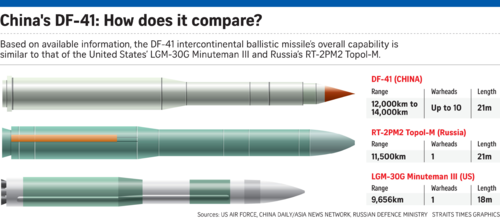Forest Green
ACCESS: Above Top Secret
- Joined
- 11 June 2019
- Messages
- 9,508
- Reaction score
- 17,401
What purpose would it serve not to respond with 'almost everything' as I stated? If someone considered it reasonable to fire 50 strategic warheads against your mainland in a pre-emptive strike, naturally their response to a limited response will be further escalation, so there's no point beating about the bush.You do not retaliate to 50 warheads with everything you got, as bad as a "limited" nuclear strike is, it is still preferable to a mass nuclear strike, and a massed retaliation will lead to a mass retaliation.
DF-31, DF-41 and RS-24 are all in the sub 50 ton "small" ICBM same as MM3. Are they more capable than MM3? Sure, at least DF-41 and RS-24 (partially because they are mobile). But they are nowhere near the 100 ton class like Peacekeeper or Trident II or the 150-200 ton ICBMs like DF-5, Satan, or Sarmat. Yes, the US is outclassed in ICBMs but at the same time it completely outclasses both Russia and China in SLBMs (different focus). The question should be, should the US even try to outclass Russia and China in ICBMs? The MM3 force is currently a enemy warhead sink, requiring at least a third of the allowed Russian warheads to take out. GBSD does not need to be better than the Russian ICBMs it just needs to be as big if not bigger of a warhead sink, the goal being to increase the cost of an enemy strike beyond that which they are willing to pay. A Peacekeeper II while being more capable could have the opposite effect in reducing the cost of an enemy strike.
Don't fall for Russian and Chinese hyperbole and propaganda. Physics is still physics. For DF-41 to carry 10 warheads to that range it would have to be at least Peacekeeper size, which it clearly is not. Sarmat with 24 HGVs is simply ludicrous. Assuming, their claims of 10 ton payload are accurate and assuming the payload is nothing but HGVs (no structure to hold them, not post-boost vehicle, no guidance, no shroud), you end up with 400kg for each HGV which is very small. Not to say anything of the deployment issues and volumetric issues.
The DF-41 is Peacekeeper-sized and the warheads are smaller/lower yield. It is stated at 80t approx., which is very similar to the LGM-118 (88t) again. And that is an approx. weight. DF-31 is aimed at only 8,000km, so could easily carry a similar payload to Trident II across that shorter range.
On Sarmat I heard 1 avantguard takes the place of 3 regular warheads, which would still be 8, or 24 regular warheads, or 4+12 etc.



